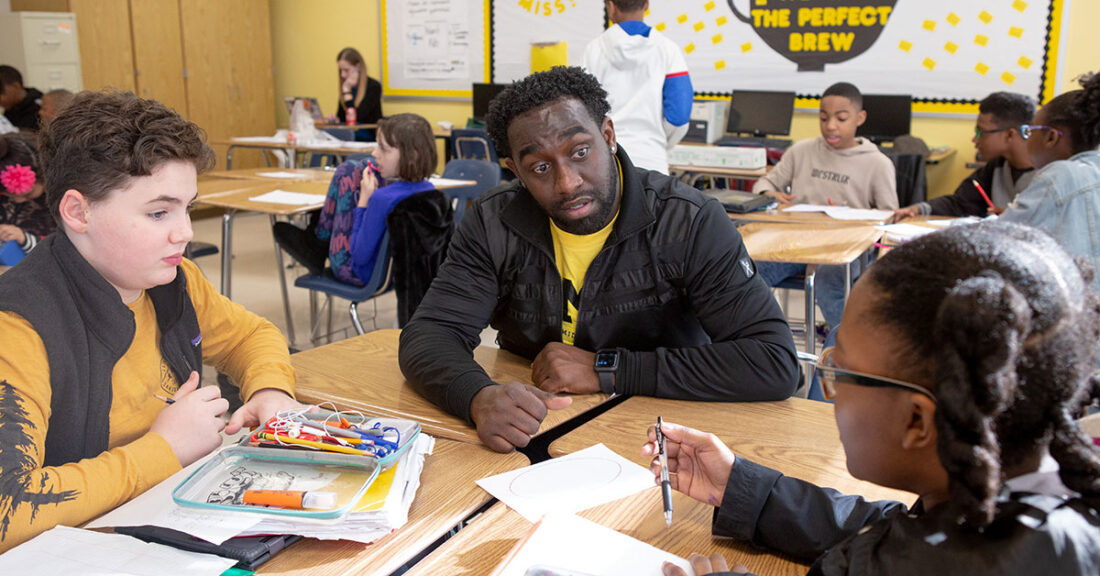Strengthening Leadership in Promise Neighborhoods

Photo by Allison Shelley for American Education
A recently released report explores the role of the Annie E. Casey Foundation’s Results Count® framework in helping federal Promise Neighborhoods grantees advance large-scale results for children and young adults.
The report, based on interviews with people involved in the Results Count technical assistance program, describes the work of a unique implementation partnership that includes the U.S. Department of Education, the Urban Institute, the Center for the Study of Social Policy and the Foundation.
“The Promise Neighborhoods program requires leaders who have the skills and tools for achieving measurable, equitable results for children and youth,” says Barbara Squires, director of Leadership Development at the Foundation. “This report shows the benefits and challenges of using the Results Count approach to build leadership capacity in Promise Neighborhoods and other complex, cross-sector initiatives.”
An emphasis on data
The Promise Neighborhoods program seeks to develop solutions that significantly improve educational and developmental outcomes for children and youth in low-income communities. Defining features of the program include an emphasis on data, evidence and a requirement that grantees propose and implement solutions to improve 10 large-scale results — such as students successfully transition from middle school grades to high school — spanning “cradle to career,” with each result measured by one or more indicators.
Seven federal grantees, both urban and rural, participated in the Promise Neighborhoods Results Count program in 2018–2019. Each grantee selected five key partners to participate in three two-day seminars over eight months that focused on leadership skills and strategy development and implementation.
To make the Results Count learning experience more manageable, all teams were asked to focus on one result (students successfully transition from middle school grades to high school) and its indicators (the average daily attendance rate and the chronic absenteeism rate for students in sixth through ninth grades).
According to the report, the Results Count topics and skills most valued by seminar participants included:
- Data — using quantitative and qualitative data as a tool to understand the effectiveness of strategies for various populations of students and how to improve those strategies.
- Results in the Center — a process for identifying the sectors (such as education and business) and the partners able to influence a successful transition to high school.
- Distinction between results for a program and larger-scale results for a whole group of people, or “population”— recognizing that the achievement of desired results for target populations goes beyond any single programmatic intervention and requires multiple disciplines, cross-organizational work and community involvement.
- Factor analysis — unpacking the programs, policies, systems, beliefs and behaviors that promote or constrain improvement in results.
- Accountability Pathway — encouraging participants to think about individual and collective accountability while keeping commitments and acting with urgency to improve results for children and families.
A valuable experience
Other less tangible, but still important, benefits cited by participants included having local partners, particularly school and district leaders, attend the seminars. One interviewee said that the site’s partners “became almost like our champions when we came back home.… Anybody who’s pretty much joined us in the session, they go back with a different perspective of and deeper understanding of what a Promise Neighborhood is.”
“Too much content and too little time” were among the challenges cited by program participants and implementation partners. Many interviewees said six days of seminars was an insufficient amount of time to fully grasp and internalize all of the Results Count tools, concepts and skills. Moreover, the time constraints severely limited discussion of Results-Based Facilitation™, one of Results Count’s two foundational skills.
Despite these and other challenges, the report concluded that many participants found the Results Count program “a valuable experience that connected them with colleagues doing similar work, provided important tools and frameworks to support Promise Neighborhoods program implementation, and encouraged them to think differently about their ultimate goals (i.e., large-scale results) and how to achieve them.”





